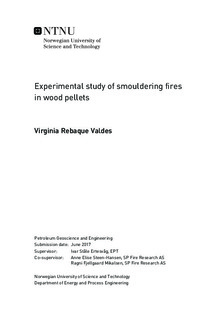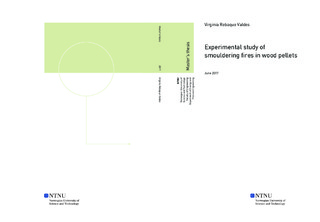| dc.description.abstract | Development of renewable energy sources for energy production has become increasingly significant in European energy markets. Energy consumption is almost completely due to petroleum, a non-renewable resource that is generating global warming because of the greenhouse effect. Due to this situation and the increase in demand and oil price, it is necessary to search for alternatives which may be used as fuel. One of the most viable alternatives is woody biomass, and specifically pellets.
Smouldering is a flameless form of combustion, sustained by the heat evolved when oxygen directly react to the surface of the fuel. Smouldering constitutes a serious fire hazard for two reasons: it typically yields a higher conversion of fuel to toxic compounds than flaming, and because it provides a pathway to flaming that can be initiated by weak heat sources. Many materials can sustain a smouldering reaction, among them wood pellets, which are becoming more widely used as an alternative to oil-fired central heating in residential and industrial buildings.
The purpose of this thesis was to study the smouldering behaviour by varying the airflow propagation. It has been used two different configurations: semi reverse and forward. These are defined according to the direction in which the smoulder reaction propagates relative to the oxidizer flow.
The project is based on experimental tests. The samples were placed in an insulated steel pipe above a heater, and heated from underneath. Temperature development, air flow measurements, smoke composition (CO, CO2 and O2) and mass loss were registered during the testing. The results showed that forward smouldering experienced a more intense combustion in comparison to semi reverse, undergoing the reaction at higher temperatures (~720ºC) in less time (~7 hours).
Three different types of smouldering were observed in the test samples: Semi reverse smouldering, Forward smouldering Type 1 and Forward smouldering Type 2. The distinction was made based on the different smouldering temperature behaviour during the tests. | |

